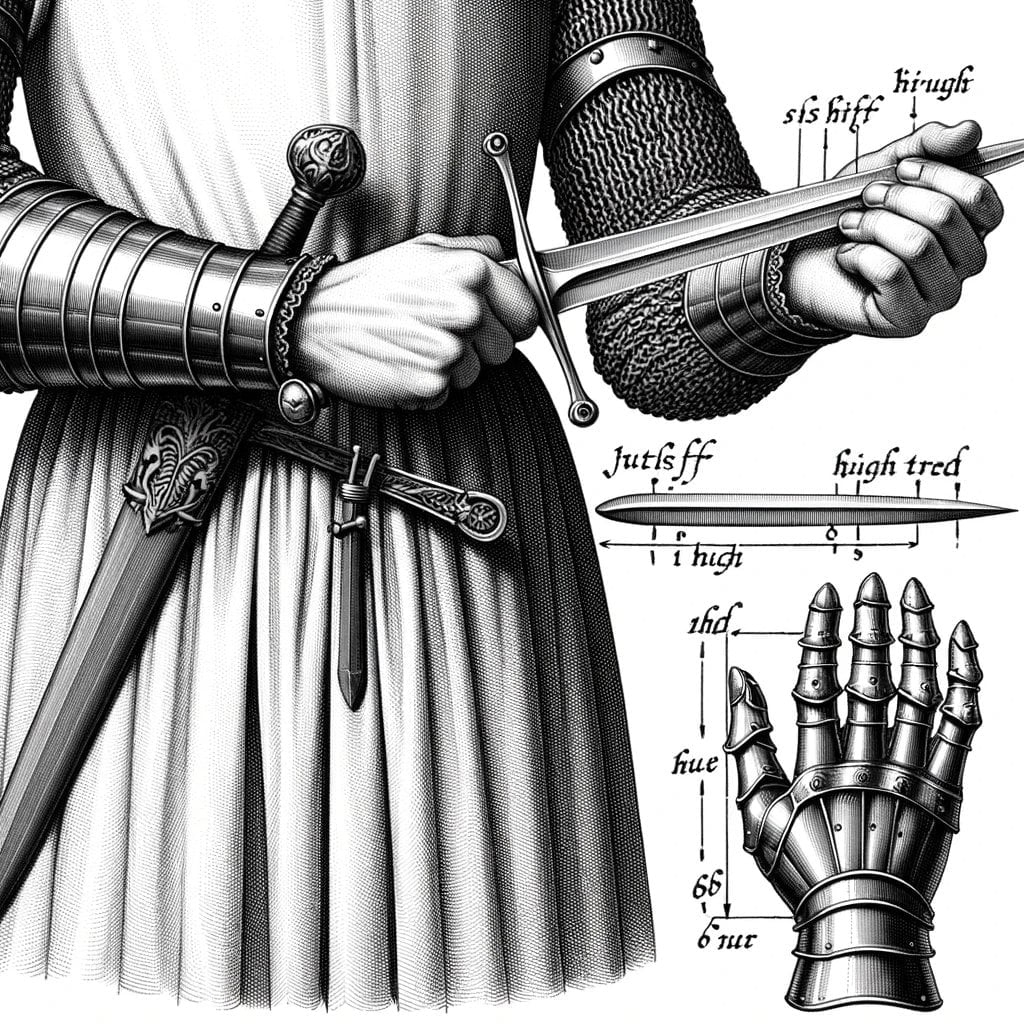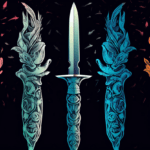The medieval dagger is a little but powerful weapon with mystique and unmatched adaptability. One mystery persists throughout history: How long was a medieval dagger? Historians, fans, and scholars have been obsessed with this mysterious question, scouring old writings, archaeological sites, and hands-on exploration. Our fascinating investigation of medieval dagger lengths will reveal their unique intricacies and compelling stories. Step back in time for a unique historical analysis.
How long was a medieval dagger?
When it comes to medieval weaponry, few weapons encapsulate the spirit of the Middle Ages like the trusty dagger. These short stabbing weapons were an essential part of a knight or soldier’s arsenal, providing a deadly backup option for close combat. But just how long were these medieval daggers? Let’s delve into the historical analysis and uncover the truth.
Understanding the Length and Anatomy of Medieval Daggers
Medieval daggers featured 12–18-inch blades for quick, precise blows. Steel made the sword durable and deadly on the battlefield. With a tapering needle point, the dagger could easily penetrate armor or discover weaknesses.
Daggers can be used in many fighting methods with single- or double-edged blades. The single-edged model permitted controlled thrusts, while the double-edged version allowed multi-directional slashing. Each option offered advantages based on the fight.
Medieval dagger handles were 4–6 inches long. This gave the wielder a solid grasp, improving battle control and movement. Round guards and pommels protected the hand and balanced the weapon.
The Role of the Medieval Dagger
After learning the proportions of a medieval dagger, let’s discuss its battlefield use. When swords or polearms failed, daggers were crucial in close-quarters fighting. Knights relied on the dagger in battle, where speed and agility were crucial.
For surprise strikes or stealthy moves, its small size made it easy to conceal. The dagger’s quickness and adaptability helped target weak points and vulnerable places against strong enemy armor. Medieval daggers were powerful in the hands of expert fighters.
Unveiling the Length of Medieval Daggers: A Historical Analysis
To answer the question “How long was a medieval dagger?” We may say that these weapons had blades between 12 and 18 inches. This small size and sharp tapering point permitted precision attacks and agile battlefield movements. The 4-6-inch handle was secure and protected by a rounded guard and pommel.
After discovering medieval daggers’ length, we must understand their historical significance and role in the Middle Ages. These short, deadly daggers showed medieval weaponsmiths’ inventiveness and expertise, whether used as primary or backup weapons.
Medieval dagger measurements help us grasp the complex realm of historical battle. So the next time you see a medieval knight or discuss medieval weaponry, you may safely discuss the length of these interesting daggers.
Though small, the medieval dagger had a big influence. Its size, designed for close battle, gave knights and soldiers a reliable and deadly weapon. Please continue to enjoy the medieval dagger’s role in battle as we find additional secrets from the past.
The table below summarizes the key dimensions of a medieval dagger:
| Component | Length |
|---|---|
| Blade | 12-18 inches |
| Handle | 4-6 inches |
Be mindful of the design and story inside a medieval dagger replica when you hold one or see one in a museum. Though short, the medieval dagger had a big impact. It was crucial to the Middle Ages’ fights and conflicts.
Mystery and fascination surround medieval dagger facts. These deadly weapons were useful for life and protection, as well as symbols of power and aristocracy. Click here to learn more about medieval daggers and their artistry and history. Hurry; don’t miss out on this captivating journey! medieval dagger facts
Factors influencing the length of medieval daggers
In the Middle Ages, daggers were important to men and women. These compact, multifunctional weapons were employed for self-defense, food cutting, and other functions. Several factors affected medieval dagger length, design, and usefulness. We shall examine the main criteria that determined medieval dagger length in this post.
1. Practicality and Functionality
Practicality and functionality shaped medieval dagger length. Daggers were used for frying and chopping meat; therefore, they needed a handy length. They needed to be long enough for duty yet small enough for daily wear.
2. Combat and Self-Defense
Medieval daggers’ close combat use also affected their length. In hand-to-hand combat, soldiers used daggers as a last resort when their main weapon was lost, damaged, or ineffective. The self-defense efficiency of medieval daggers depended on their length. Longer blades penetrated deeper and reached farther, giving the user an advantage in fighting.
3. Regional and Cultural Variations
Regional and cultural factors affected medieval dagger length. Weapon styles and preferences varied by area. The Saxons used seax daggers with slightly curved blades that ranged from shorter for everyday use to longer for combat. Late medieval rondel daggers have long, stiff blades for armor piercing.
4. Fashion and Aesthetics
Fashion and aesthetics influenced medieval dagger length. Functional weapons also symbolized rank and money. Thus, fashion trends may affect medieval dagger length. The 16th century saw daggers become more elegant and thin than swords. Due to fashion trends, daggers got shorter and more elegant.
A Historical Perspective on Dagger Lengths
To provide a clearer understanding of the different lengths of medieval daggers, here is a table showcasing some notable examples:
| Dagger Type | Length Range | Primary Use |
|---|---|---|
| Seax | 6-18 inches | Everyday tasks, self-defense, combat |
| Stiletto | 8-15 inches | Piercing armor, close combat |
| Falchion | 15-24 inches | Slashing and hacking |
| Bollock Dagger | 8-14 inches | Self-defense, close combat |
| Rondel Dagger | 12-18 inches | Armor penetration, self-defense, combat |
In conclusion
Medieval dagger length must be considered in light of their utility, combat efficiency, regional variances, and fashion trends. Each component affected length, resulting in a variety of daggers with different uses and designs. Understanding these effects illuminates medieval daggers’ history and relevance.
When you see a medieval dagger in a museum or collector’s exhibit, admire the thought and consideration that went into making its length adaptable and intriguing.
Analysis of archaeological evidence and ancient manuscripts on dagger lengths
Archaeological data and texts are significant for understanding medieval dagger length. These important sources illuminate these ancient weapons’ size and variances. By studying these documents, we can solve medieval dagger-length puzzles and comprehend their importance.
Examining archaeological evidence
Antiques, including medieval daggers, have been found during archaeological investigations. Experts have determined these weapons’ size through careful analysis. They investigated daggers’ manufacture, preservation, and physical remains to determine their length.
Modern methods like p-XRF and MC-ICP-MS have been used to examine antique dagger composition. These approaches allow researchers to determine the substance, which reveals the dagger length. Many samples can be compared and analyzed to better understand dagger lengths.
Ancient manuscript analysis
Ancient writings and archeological evidence are crucial for medieval dagger research. These documents describe, illustrate, and provide thorough dagger manufacturing and use instructions. Historians and researchers can learn medieval length preferences by researching these manuscripts.
Ancient writings show different-length daggers. These pictures’ descriptions often explain dagger lengths’ practical uses. Manuscripts may indicate how some lengths were preferred for common chores like cutting food and others for self-defense in close battle.
Disclosing
Examining medieval dagger length requires considering the circumstances that shaped it. Since daggers were versatile, practicality and functionality were important. Different cultures and regions developed their own dagger length preferences.
Fashion and aesthetics also affected dagger length. Beyond their function, these weapons symbolized riches and status. Fashion and prestige may affect lengths. These factors help us understand medieval daggers’ historical context and value.
Several types of medieval daggers stand as notable examples, each with its own range of lengths. These examples provide a glimpse into the diversity of dagger dimensions:
- The Seax: Ranging from 6 to 18 inches in length, the Seax was a versatile dagger commonly used by Germanic tribes during the early Middle Ages.
- The Stiletto: With lengths varying from 8 to 15 inches, the Stiletto was a slender dagger characterized by its needle-like point. It served as both a weapon and a tool for delicate tasks.
- The Falchion: This curved single-edged weapon ranged from 15 to 24 inches in length. It was favored by knights and foot soldiers alike for its cutting power.
- The Bollock Dagger: Ranging from 8 to 14 inches in length, this dagger stood out for its distinctive shape, resembling male genitalia. It was popular throughout Europe during the Middle Ages.
- The Rondel Dagger: With lengths between 12 and 18 inches, the Rondel Dagger featured a round or octagonal blade section and was primarily used for thrusting attacks.
FAQ
Question 1: What was the typical length of a medieval dagger?
Answer: The length of a medieval dagger varied depending on the specific type and purpose. However, on average, medieval daggers ranged from 6 to 18 inches in length.
Question 2: Were daggers primarily used as weapons or tools during the Middle Ages?
Answer: Daggers served multiple functions during the Middle Ages. While they were primarily designed as close combat weapons, they also served as all-purpose tools for tasks such as cutting meat, cooking, and other mundane activities.
Question 3: What were some common types of medieval daggers?
Answer: Some common types of medieval daggers include the seax, stiletto, falchion, bollock dagger, and rondel dagger. The rondel dagger, with its long and stiff blade, was particularly popular during the late Middle Ages.
Question 4: What materials were medieval daggers made from?
Answer: Medieval daggers were crafted from a variety of materials, including iron, steel, flint, ivory, bone, and copper. These materials were chosen for their durability and functional qualities.
Question 5: What is the significance of medieval daggers in modern times?
Answer: While daggers are no longer primarily used as weapons, they hold significant historical and cultural value. They are often collected as antiques and used in mock combat or reenactments to recreate medieval battles and showcase historical craftsmanship.
- Star Ring Trends: Etsy vs Amazon - March 28, 2025
- Boost Pollinator Habitats: Baby Blue Eyes Sustainable Farming Guide - March 28, 2025
- Protect Big Black Bears: Effective Conservation Strategies - March 28, 2025



















